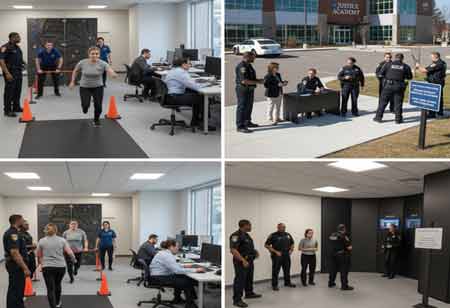THANK YOU FOR SUBSCRIBING
Be first to read the latest tech news, Industry Leader's Insights, and CIO interviews of medium and large enterprises exclusively from Gov CIO Outlook
THANK YOU FOR SUBSCRIBING

By
Government CIO Outlook | Thursday, October 30, 2025
Stay ahead of the industry with exclusive feature stories on the top companies, expert insights and the latest news delivered straight to your inbox. Subscribe today.
In an era defined by calls for greater transparency and accountability, public trust has become the single most critical asset for any law enforcement, fire, or emergency services agency. This focus has catalyzed a profound evolution in how agencies select and manage their personnel. The traditional, static, and point-in-time background check is rapidly giving way to a more dynamic, holistic, and continuous vetting model. This shift isn't merely an upgrade of old processes; it represents a new philosophy, one that views vetting not as a single hurdle to clear, but as an ongoing commitment to excellence, wellness, and public confidence.
The Evolution of Pre-Employment Vetting
Pre-employment vetting has evolved far beyond a simple “go/no-go” decision based on criminal history. Modern agencies now seek candidates who not only meet basic qualifications but also demonstrate critical competencies such as emotional intelligence, resilience, cultural awareness, and sound judgment under pressure. This shift reflects a broader understanding that success in public service requires not only integrity but also the ability to navigate complex human and social dynamics effectively.
A key development in this evolution is the rise of digital background checks, which employ advanced analytics to evaluate a candidate’s publicly available online activity. Using technologies such as natural language processing (NLP) and image analysis, agencies can systematically review social media posts, forums, and other digital interactions to identify indicators of bias, extremism, or poor judgment. This process creates a comprehensive view of a candidate’s character and alignment with the values expected of public servants. Complementing this, psychological screening has also modernized—incorporating psychometric tools and scenario-based assessments that measure emotional regulation, decision-making, and empathy in realistic, high-pressure environments. These tools enable agencies to identify not only potential risks but also positive traits that predict long-term effectiveness and stability in demanding roles.
Comprehensive data aggregation has transformed background investigations into a holistic process. Integrated platforms now consolidate data from criminal, financial, and civil records, as well as national and international watchlists, allowing agencies to detect behavioral patterns that might previously have gone unnoticed. By connecting disparate data points—such as financial instability or repeated minor infractions—investigators can gain deeper insights into a candidate’s reliability and judgment. This unified, data-driven approach enables agencies to make more informed hiring decisions that balance risk mitigation with the proactive identification of individuals who embody the highest standards of public service.
The Rise of Post-Employment Vetting
One of the most transformative developments in public safety is the growing recognition that vetting does not conclude at the time of hire. The demanding nature of public safety work can influence behavior over time, and even well-intentioned individuals may make poor decisions long after passing their initial screening. This understanding has led to the emergence of continuous evaluation, also known as post-employment vetting—an ongoing process designed to ensure accountability and integrity throughout an employee’s tenure.
Increasingly, agencies are implementing systems that deliver daily, automated alerts on personnel activities by monitoring a broad range of data sources, including criminal booking records, court filings, motor vehicle databases, and other public information streams. For example, suppose an officer is arrested in another jurisdiction over the weekend. In that case, agency leadership is notified immediately rather than discovering the issue months later during a scheduled review or through media coverage. This timely awareness allows organizations to take swift administrative or supportive action, reducing potential risks and reinforcing public trust. Continuous monitoring now extends into the digital sphere, identifying public-facing social media content that may violate departmental policies or damage the agency’s reputation.
Beyond simple misconduct alerts, modern continuous vetting incorporates data-driven Early Warning Systems (EWS) designed to be preventative and supportive rather than punitive. These systems analyze internal data sources—such as use-of-force reports, citizen complaints, internal affairs records, dispatch logs, and attendance data—to detect emerging behavioral trends. For instance, an officer exhibiting a sudden increase in citizen complaints and use-of-force incidents may be flagged for supervisory review, even if each incident individually complies with policy. Such early identification functions as a “check engine light” for personnel, signaling potential issues such as burnout, stress, or training gaps. This enables non-disciplinary interventions, including wellness referrals, mentorship, or additional training, before performance declines or misconduct occurs.
The Technological Engine of Modernization
The transformation of public safety vetting is being driven by powerful technological platforms that serve as the foundation for modern workforce management. Secure, cloud-based systems now oversee every stage of an officer’s career—from recruitment to retirement—while artificial intelligence (AI) and machine learning (ML) enhance accuracy and insight. AI enables the rapid analysis of extensive digital footprints, while ML powers early warning systems (EWS) that learn from agency-specific data to detect behavioral anomalies. These platforms also excel at data integration, breaking down long-standing silos between Human Resources, Internal Affairs, Training, and Operations to create a unified, 360-degree view of each employee.
This shift represents a move from static background checks to dynamic, real-time monitoring—a transition from a “snapshot” to a “streaming video” of an officer’s professional journey. The goal has evolved beyond simply filtering out unsuitable candidates; it now focuses on identifying, supporting, and developing the most capable individuals while enabling proactive interventions when needed. By combining data, analytics, and a philosophy of continuous assurance, public safety agencies are laying the groundwork for a more transparent, accountable, and resilient workforce—ultimately rebuilding and sustaining public trust for the future.
The lifecycle of accountability in law enforcement hiring provides agencies with a mechanism to demonstrate, every single day, their unyielding commitment to the community. By establishing a culture of perpetual assurance, public safety organizations are not just restoring trust; they are building a future workforce that is inherently more transparent, effective, and worthy of the public’s faith.
I agree We use cookies on this website to enhance your user experience. By clicking any link on this page you are giving your consent for us to set cookies. More info



